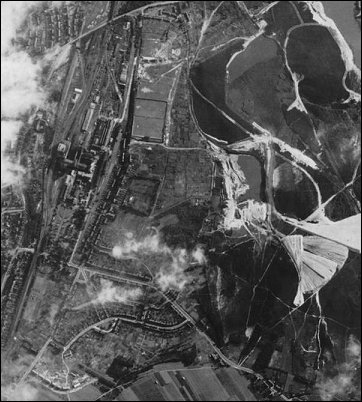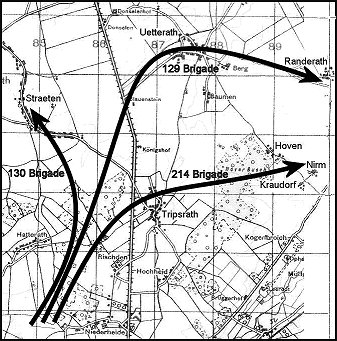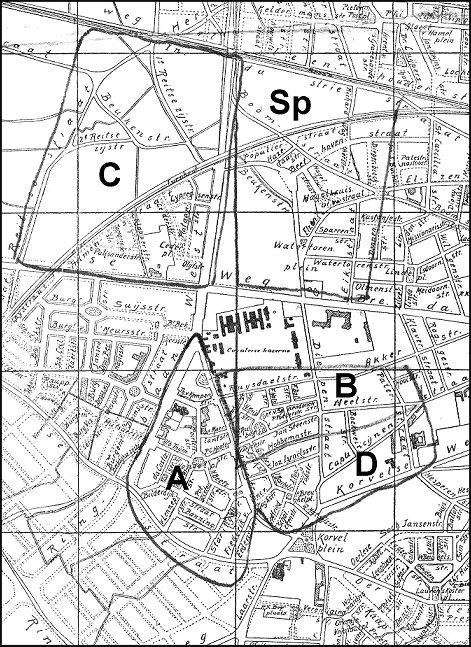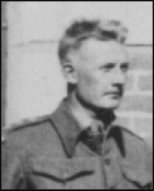Tripsrath - Brunssum for the second time
On the 6th December 1944 the Worcesters were relieved by 4th Wiltshires and, preceded by the usual recce party (the Second-in-Command, all Company seconds-in-commands, and representatives of all specialist platoons) crept back down the village streets. Unfortunately a 17-pounder anti-tank gun took the wrong turning at the church leaving Birgden and drove towards Schierwaldenrath, which was still in enemy hands. It ran into a minefield, blew itself and its crew sky-high causing an almighty explosion. The Worcesters eventually arrived once more at Brunssum at 23.30 hours and debussed at the air-raid shelters of the coalmine.
On the following morning (7th December) the 1st Battalion Worcestershire Regiment Commanding Officer, Lieut.-Col. Vickers, inspected the troops' quarters and ordered that civilian billets be found forthwith. This was achieved with little trouble or delay, the men once more enjoyed the warm welcome of the Dutch folk.
Aerial photo of Prins Hendrik Staatsmijn at Brunssum |
Theo Geerssen (Torenstraat, Brunssum) then age 12, remembers the men of the Worcestershire Regiment arriving particularly Captain Jock Bannister and his batman Corporal Colin Amor who were billeted at his home. Theo recalls the event: “One day in December the families living in the Torenstraat were asked to billet members of the Worcestershire Regiment. I remember that my parents did not hesitate and agreed to have two soldiers just coming from the German Front. We were a family of five; my father, mother, my sister (15), my little brother (4) and myself (12). I remember that I was a very proud boy, bragging to my friends that we had a Captain at our home. Conversation was a bit difficult as I was in fact the only one who did speak a little English. But we certainly managed to make clear what we wanted to say. I remember one day Captain Bannister asking my mother if she was in need of certain goods for instance for the kitchen. After 4 years of war there were several things we were short of. So my mother told him that if he could manage some cooking pots, she would be very grateful. That night Captain Bannister went on a reconnaissance into Germany. Next morning he returned with a large dish washing pan and a large piece of meat. He asked my mother to prepare a nice home cooked meal for him, his batman and for the whole family. It was great. In the afternoon during the dinner Captain Bannister had a visitor, another officer who happened to speak German fluently. He said that with your permission he would love to have some dinner too. My mother was very pleased.” Note: The other officer that called was Captain Keith James. During this period of inactivity Field-Marshal Montgomery ordered 30 Corps to make plans to clear the enemy from the a three-cornered area bounded by Roermond in the north, Sittard in the south and the River Roer to the east. This area later became know as the Sittard-Roermond Triangle. This operation was given the codename 'Shear'. This operation would then allow for the destruction of the enemy west of the Rhine. |
As part of this plan the Worcesters were to open up the route in front of Tripsrath and hold it. The 52nd (Lowland) Division would then push through and take the town of Heinsberg. The Guards Armoured Division would then breakout at Birgden and push forward. By the 10th December the American 84th Division had been brought in to the plan. However, poor weather conditions and major traffic problems on the Heinsberg Road caused the planned attack to be postponed to the 14th. The situation continued to get worse and the following day it was put back yet again to the 16th. The weather conditions deteriorated still further when finally the operation 'Shear' was abandoned on the 12th December. Field-Marshal Montgomery had in fact decided to give priority to the attack south-east from Nijmegen, which 30 Corps had planned in October, known as operation 'Veritable'. On the 16th December Worcesters were ordered to send a recce party to Aalbeek, no one ever knew quite why. The party was recalled almost before it arrived there and was dispatched on the following day (17th December) to Tilburg. Private Thomas Scully (now moved to ‘D’ Company with Captain Percy Huxter) remembers being a member of this Recce Party to Tilburg where he arranged billets in the local houses of Hobbemastraat and Jozef Israëlsstraat, for 16, 17 and 18 Platoon of ‘D’ Company. He learnt to use the following Dutch phrase “Wilt U geven biljets voor soldaten, hoeveel” translated meant “Will you provide billets for soldiers, how many”. |
Original 43rd Division attack plan for |
Tilburg map used to allocate Worcester Company billets |
It was not generally known until long afterwards that the object of this move was to allow the Worcestershire Battalion a period of special training prior to committing it as part of the force to make the assault on the Siegfried Line on 9th January 1945. The Recce Party procured billets in Tilburg and the Battalion moved off from Brunssum to occupy them at 09.00 hours on the 18th December. In Tilburg the location of the billets were in the streets around the “Cavalerie Kazerne” which were the Cavalry Barracks situated in the south west part of the town. The section of the map on the next page was that used by the Battalion at the time and shows the location areas of the individual Company billets, as marked up by Lieutenant Rex Fellows (‘B’ Company). It was expected that the Battalion would have a month out of the line devoted to training. However, news came in that Von Rundstedt had launched a full scale mechanised offensive through the Ardennes, aimed at splitting the American 9th and 1st Armies, cutting across the southern part of Belgium. After only a short stay in Tilburg the Worcestershire Battalion was ordered to concentrate hastily in the Belgian town of Bilzen (19th December). Troop Carrying Vehicles arrived outside their billets the men quickly jumped on and were on there way south. It was whilst in Tilburg that the Battalion found itself directly under the flight path of the V1 ‘flying bombs’ directed on Antwerp. They came over the town at night in regular half hour intervals. Von Rundstedt's last throw in the form of his Ardennes Offensive had caused the best-laid plans of the General Staff to go slightly astray. So it was that the Battalion were to wait in reserve at Bilzen with the rest of 214 Brigade. It must be confessed that the Allies had now been pushing back the Germans for so long that for a while no one really took the Ardennes Offensive seriously. By the 20th December, however, it had become apparent that it was a major operation and more than mere tactics. For the Germans the whole issue of the war was at stake. |
Capt. Freddie Coulcher |
On the 17th December, Captain Freddie Coulcher (commanding Anti-Tank Platoon) was taken ill and was evacuated to hospital in Brugge. Only a few weeks before he had complained of having stomach pains and at the beginning of December went into hospital for Xrays and further investigations but these proved inconclusive and he had discharged himself on 11th December. On the 17th December 1944, Captain Chalmers (M.O.) insisted he return to hospital which he did on 17th December. He was taken to a hospital in Brugge. On the 30th December 1944, whilst still in hospital, he again complained of stomach pains and it was therefore decided to perform an operation known as a retrograde pyelography for the investigation of renal colic. After the operation Captain Coulcher's condition steadily deteriorated and in spite of constant attention he died the same day (around 5pm). It was found that his death was the result of sodium tellurite and enquiries revealed that during the operation a powder taken from a bottle labelled "sodium iodide" was administered in solution, but it was later established that this bottle, in fact, contained sodium tellurite. Investigations showed that the label "sodium iodide" was on the bottle concerned before it reached. In other words he died of poisoning, his underlying illness was still a mistery. Captain Freddie Coulcher is buried in a war grave at Brugge General Cemetery (Plot 63, Row 4, Grave 5). |




